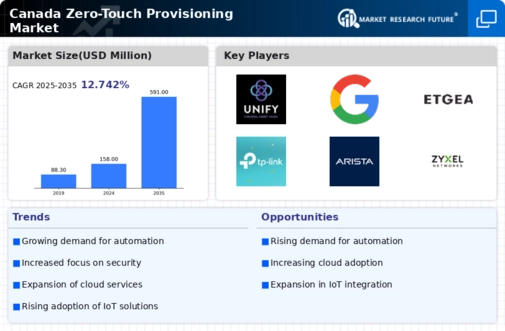Growing Focus on User Experience
The zero touch-provisioning market in Canada is witnessing a growing focus on user experience as organizations strive to enhance customer satisfaction. Companies are increasingly aware that a seamless onboarding process for devices can significantly impact user engagement and retention. By implementing zero touch-provisioning solutions, businesses can ensure that users have a smooth experience from the moment they receive their devices. This emphasis on user experience is supported by data indicating that organizations prioritizing customer satisfaction see a 20% increase in user retention rates. As Canadian enterprises recognize the importance of delivering exceptional user experiences, the zero touch-provisioning market is likely to benefit from this trend, driving further adoption of automated provisioning solutions.
Regulatory Compliance and Data Security
Regulatory compliance and data security are becoming increasingly critical drivers for the zero touch-provisioning market in Canada. With the rise of stringent data protection regulations, organizations are compelled to adopt solutions that ensure compliance while safeguarding sensitive information. Zero touch-provisioning offers a streamlined approach to device management that enhances security protocols and minimizes the risk of data breaches. Recent reports indicate that 70% of Canadian businesses are prioritizing compliance with data protection laws, which directly influences their procurement decisions. As organizations seek to align their operations with regulatory requirements, the zero touch-provisioning market is expected to grow, driven by the need for secure and compliant provisioning solutions.
Technological Advancements in Networking
Technological advancements in networking are playing a pivotal role in shaping the zero touch-provisioning market in Canada. The emergence of next-generation networking technologies, such as 5G and Wi-Fi 6, is facilitating faster and more reliable connectivity. These advancements enable seamless device provisioning and management, which is crucial for organizations looking to enhance their operational capabilities. As Canadian businesses increasingly adopt these technologies, the demand for zero touch-provisioning solutions is expected to rise. The integration of advanced networking capabilities allows for real-time monitoring and management of devices, thereby improving overall efficiency. This trend suggests that the zero touch-provisioning market will continue to evolve in response to the rapid pace of technological innovation.
Cost Efficiency and Resource Optimization
Cost efficiency remains a critical driver for the zero touch-provisioning market in Canada. Organizations are increasingly recognizing the financial benefits associated with automating device provisioning processes. By minimizing manual intervention, companies can significantly reduce labor costs and improve resource allocation. Recent studies indicate that businesses utilizing zero touch-provisioning solutions can achieve up to 30% savings in operational expenses. This financial incentive is compelling for Canadian enterprises, particularly in a competitive market where cost management is essential. As organizations strive to optimize their IT budgets, the zero touch-provisioning market is poised for growth, driven by the need for cost-effective solutions that enhance productivity while minimizing expenditures.
Rising Demand for Remote Management Solutions
The zero touch-provisioning market in Canada is experiencing a notable surge in demand for remote management solutions. As organizations increasingly adopt remote work policies, the need for efficient device management has become paramount. This trend is reflected in the growing number of enterprises seeking to streamline their IT operations. According to recent data, approximately 65% of Canadian businesses are investing in remote management technologies, which directly influences the zero touch-provisioning market. The ability to deploy and manage devices without physical intervention not only enhances operational efficiency but also reduces costs associated with on-site support. Consequently, this driver is likely to propel the growth of the zero touch-provisioning market, as companies prioritize solutions that facilitate seamless remote management.























Leave a Comment